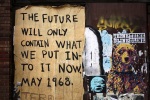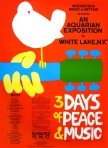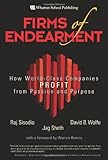As from now, we offer you weekly updates related to our 5th edition of Innotribe at Sibos in Dubai from 16-19 Sep 2013.
As you probably know by now, we’ve designed our programme like a metro map. Just like the underground or subway, it’s up to you to decide which “track” to follow, depending on your expertise, interests, learning objectives, and availability.
In this week’s post, we’d like to walk you through the Innovation Track at Innotribe@Sibos 2013.
We’ll move away from the traditional polarizing discussions such as old vs. new, startups vs. incumbents, incremental vs. disruptive, close vs. open, core vs. non-core and we will help you discover the richness of the options in the middle of the extremes and help you identify which model to best apply in your company. All examples will have specific relevance to financial services.
The track will open with disruptions impacting the traditional banking model. We will also offer you some practice sessions about new non-linear ways of thinking to help you succeed in the ever faster changing world. The track continues with a session that offers deep insights into what else is out there beyond open innovation. The track ends on Thursday morning with a selection of “Power Talks” illustrating how new players are already significantly disrupting banking – and not just the fringes of our industry, but already heading for the core with early signs of scale. We’re not talking about the distant future, but what’s happening right now!
Future of Money
Location: Innotribe Space
Day: Monday 16 Sep 2013
Time: 09:30 – 10:30
This session is also part of the Value track.
We had a post about that last week: http://innotribe.com/2013/08/05/the-value-track-explained/
Toolkit: Better decision-making through creative techniques
Location: Innotribe Space
Day: Monday 16 Sep 2013
Time: 15:30 – 17:00
Decision-making is “making sense” of things. This raises issues of what criteria we bring to decisions when contexts change. Most of economic history industry has been driven by new developments in sense awareness.
This context changes are very significant because what digital does is alter decision-contexts. It makes us have to respond to more changes, more often and make more decisions in a more delegated way, against a backdrop of criteria that we are having to capture and describe.
This is a “Toolkit” session: an immersive learning experience to help you internalize the basic principles of creative thinking to help improve judgment and decision-making. The audience will learn to internalize the difference between linear and non-linear decision taking, complemented with practice exercises based on creative decision-making based on colour, word, and sound.
We will setup 3 separate experimentation stations:
- Art school with Dave
- Word school with Haydn
- Music school with Petervan
Speakers
- Dave Gray, Author, The Connected Company: Dave is world authority in visual thinking
- Haydn Shaughnessy, Author, The Innovation Lifestyle. Haydn is a deep thinker and expert on innovation.
Toolkit: Planning for Unpredictable Futures
Location: Innotribe Space
Day: Tuesday 17 Sep 2013
Time: 09:30 – 10:30
Another “Toolkit” session: an immersive learning experience to help you internalize the basic principles of scenario thinking in support of better future planning. This session will lead into the Network Insights session later that day. We will detail this session in the upcoming blog post on the Big Data track.
Speaker:
- Daniel Erasmus, Owner, Digital Thinking Network. Daniel brings the unique combination of scenario thinking and big data.
- Fabian VandenReydt, Head of Securities Markets and Core Business Development at SWIFT
Toolkit: Thinking in Images
Location: Innotribe Space
Day: Tuesday 17 Sep 2013
Time: 16:30 – 17:30
Visualization is increasingly used in business and science to simplify complexity: a picture is worth a thousand words. Drawing is a natural process for thinking, exploring ideas and learning. Every child enjoys drawing — but at some point in our lives we learn that drawing is the province of artists. We begin to say things like:
- “I’m no artist”
- “I can’t draw a straight line”
- “I can’t draw a stick figure”
This is a fallacy. You can draw, and when you were a kid you knew it. You just forgot. It’s time to remember what it was like to draw as a child — and to rediscover the joy of exploring ideas and learning without boundaries. It’s time to forget that you don’t know how to draw. Play isn’t just for fun. It’s how we learn. You can practice your visual thinking skills and have fun at the same time. Enjoy yourself, and take some new abilities back to work with you.
The room will be set-up like a classroom, with the audience as students. Like a Zen-master with his disciples, Dave Gray – one of the masters in the field of visual thinking – will help his students discover step by step their hidden power of visual expression.
New Innovation Models
Location: Innotribe Space
Day: Wednesday 18 Sep 2013
Time: 09:30 – 10:30
Our speakers will first give you a fascinating overview on what’s new in innovation models: from “castle and sandbox” one way of doing Open Innovation, to incremental innovation, disruptive innovation, narrow innovation, Jugaad innovation, Reverse innovation, Shanzai innovation (copycatting), computational innovation, radical adjacencies, and algorithmic innovation.
After the intro, we offer you two immersive learning experiences:
- Copycatting feels like a taboo in innovation. What if we could get rid of these taboos, and innovate again like kids? In this exercise we will actually train you to copycat, by copying one of the newcomers in payments space. In the coming days, we will also publish here and on swift.com an op-ed by Jaspar Roos, based on a research he did on copycatting.
- Crowd-source everything. We will practice how to involve crowds in innovation decision-making: how can a crowd shape a product? How can we crowd-develop, crowd-manage and crowd-design for example. You will be invited to pick one of your existing processes and crowd-source it. Also here, an article based on Haydn’s research on crowd-activities will be published soon.
Speakers
- Jaspar Roos, Chief Inspiration Officer, ABN AMRO Dialogues FutureIdeas.eu and Ventur.es
- Haydn Shaughnessy, Author, The Innovation Lifestyle
Powertalks: Best innovations in Fintech
Location: Innotribe Space
Day: Thursday 19 Sep 2013
Time: 09:30 – 10:30
Inspired by TED Power Talks, we have invited some awesome innovators from the financial industry to present real, live innovations, which are in the market and starting to scale. In other words, this is not about Star Trek, but actual innovations, where the “rubber meets the road”.
- Patrick Griffin, Head of Business Development of OpenCoin, the organization that first built the Ripple protocol. A Ripple is a unit of the native currency that exists in the Ripple network. The Ripple network is a peer-to-peer payment network. It enables free payments to merchants, consumers and developers, and to send and receive money in dollars, euros, yen or Bitcoin without having to do extra work for foreign exchange transactions and without charge backs. Ripple is also an open source protocol created for anyone to build on top of or use.
- Kristoffer Lawson, Co-Founder & Chief Evangelist, Holvi. Kris will talk about Holvi’s upcoming European launch and his work as initiator of the Popup Society movement: setting up a company, forming a team and building a product, all within 48 hours. In true popup fashion many of these ideas die immediately, but not all. Some have gone on to become great companies.
- Jaspar Roos will showcase some of the latest innovations in financial services his teams build over the last year in his different roles as Chief Inspiration Officer, ABN AMRO, Dialogues, FutureIdeas.eu and Ventur.es
- Manu Sporny, Founder/CEO, Digital Bazaar and Chairman PaySwarm will share what happens if payments get commoditized to the level of the W3C protocol? Manu spends most of his time creating open standards and open technology that will integrate payments into the core architecture of the Web. His vision is to democratize finance, making the financial tools that are only available to large organizations today, available to everyone on the Web.
Closing Plenary Innotribe: “Around the campfire”
Location: Innotribe Space
Day: Thursday 19 Sep 2013
Time: 14:30 – 15:30
Later in the afternoon on Thursday – at 14:30pm – we will all join the Closing Plenary Innotribe: “Around the campfire”, where we will share the lessons, tools and techniques learned during the week. We are very proud to confirm our two tribal wise men:
- JP Rangaswami (Chief Scientist of Salesforce.com and direct report of Marc Benioff) and;
- Andrew Davis (Global Head of e-Commerce Strategy and Innovation, HSBC).
More information about the Innotribe@Sibos 2013 programme can be found in our programme Brochure (PDF flyer), on Sibos.com and of course Innotribe.com. The full Innotribe 2013 speaker list with bios is here.
By @petervan from the Innotribe Team


















![Reblog this post [with Zemanta]](https://i0.wp.com/img.zemanta.com/reblog_e.png)




